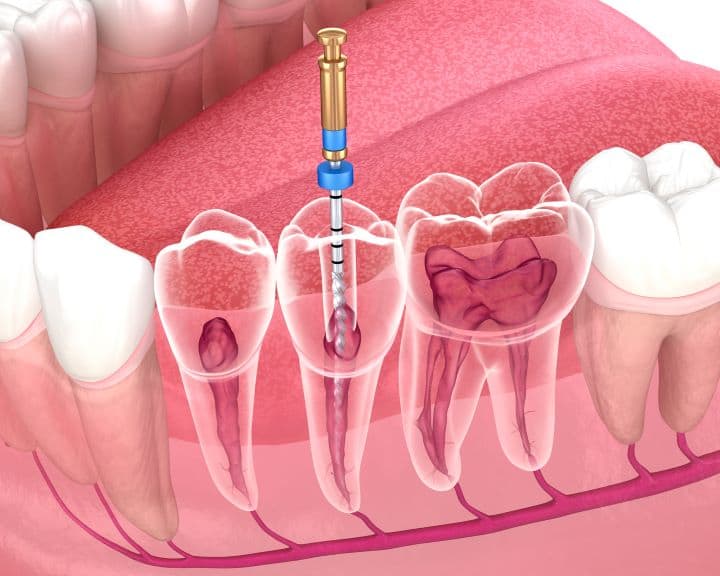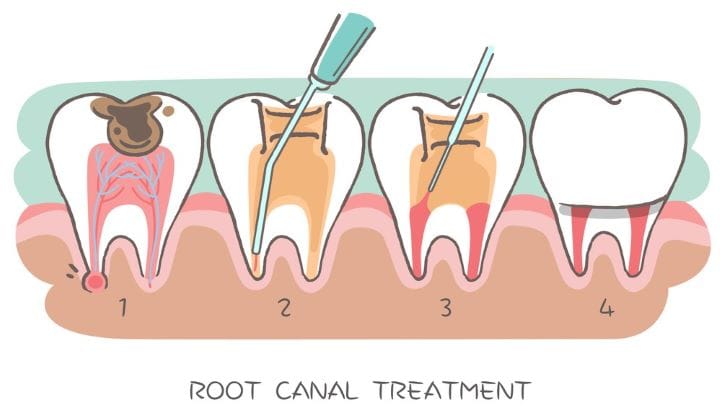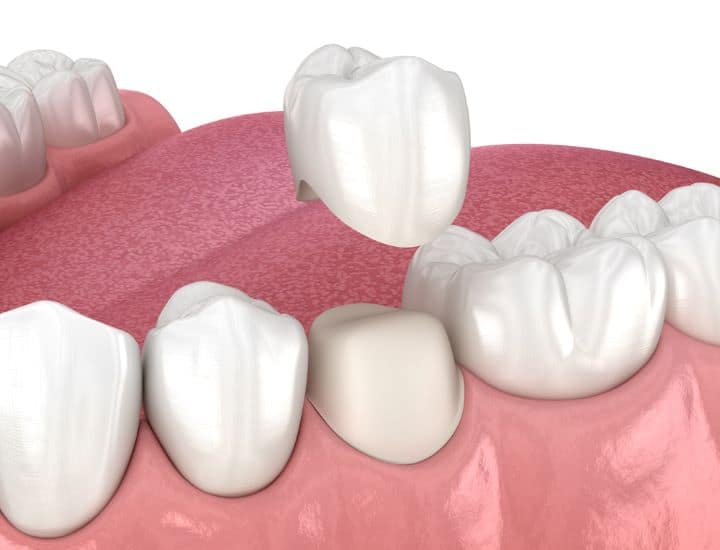Did you get recommended by your dentist or endodontist for root canal therapy (RCT) after feeling a toothache?

If this is your first time getting a root canal procedure done, chances are that you aren’t privy to the particulars about it.
Do you need it? Will it be painful? How long does it take to recover? Can you get away with ditching it? Will it cost you an arm and a leg? You may be riddled with a horde of questions. But worry not as we take you on this crusade to discover the truth about RCTs.
A root canal treatment is usually described as a straightforward procedure. If you do decide to go through with it, it will make you one of 15 million root canal treatments performed in the U.S. each year.
Let’s see how you can restore your stunning smile with a root canal.
Parts of a tooth: Enamel, Dentin & The Tooth pulp
The human tooth is made up of two main parts: the crown and the root. Additionally, multiple layers form the tooth substance, namely the outermost enamel, the inner dentin, and the innermost pulp. A layer called cementum also substitutes the enamel in the tooth’s root portion.
The center of the tooth root is called the root canal and houses the pulp. The pulp is a tissue that contains the nerves and blood vessels, responsible for allowing the tooth to feel sensations like temperature awareness, sensitivity, or even pain.
When there is an infection in the root canal of a tooth, it leads to the formation of tooth abscesses – a telltale sign that the tooth may need an RCT.
What is a root canal treatment?
A root canal treatment, colloquially known as a root canal is a dental procedure in which the infected or inflamed pulp tissue inside the tooth is removed and the canal cleaned and disinfected.

A root canal can be done by general dentists or root canal specialists known as endodontists. This procedure is designed to kill off the bacteria from the infected tooth canal while at the same time saving the tooth’s natural structure and preventing reinfection.
Do You Need A Root Canal?
According to the American Association of Endodontists, your tooth may need root canal treatment if you have any of these symptoms:
- Tooth pain: Several factors can cause your tooth to ache, however, if it does not go away, it might suggest a more severe underlying issue.
- Tooth decay: If you can see an exterior hole in the tooth that is causing you pain even after a fill, it might suggest that you need to get an RCT.
- Fracture: If there are visible fractures or chips in the tooth that are causing you pain, it might also call for a more comprehensive treatment.
- Swollen gums: If you have an infected tooth, it can cause an infection in your gums as well. As a result, your gums may swell on the side of the tooth.
- Gum pimples: Severe decay or fractures can often lead to infection or abscessed tooth. When this happens, there might be boils or pimples on your gums that may ooze pus. This is a sign that you need to undergo a root canal.
When should I see my dentist?
Endodontic treatment like root canal therapy is typically sought when the innermost soft pulpal tissue of the tooth, becomes infected or inflamed.
While there are a variety of reasons that can cause infection of the pulp, including tooth decay, cracks, or trauma, your pulp may be infected even if you do not have any tooth pain. Pulpal inflammation left untreated can cause dental abscesses.
You should go for a checkup if you see any of the aforementioned signs like prolonged pain, swollen or tender gums, darkening gums, and lingering sensitivity to hot or cold. Your dental service provider may suggest that you need a root canal done.
The Root Canal Procedure Explained
Root canal treatment is a common procedure that begins when the dentist identifies where the problem is and which tooth needs immediate attention. This article dives into the world of “root canal explained” as we take you step-by-step through the procedure.
What happens during root canal treatment?
- Access Opening
A root canal treatment is usually done throughout two or more visits. At the beginning of treatment, the dentist will take X-rays of your tooth to analyze the extent of damage. You may receive a local anesthetic to manage the pain during the procedure.

Then, the dentist will place a rubber-like sheet called a dental dam in your mouth to isolate the tooth from moisture. They may also use special instruments on the tooth to scrape and scrub away any tartar or decay.
After the tooth is thoroughly cleaned, an opening is made through the tooth crown to gain access to the pulp chamber. This is known as an access opening and will be done to remove any infected tissue.
- Cleaning and shaping the canal
Once the diseased pulp is removed, the now-open pulp chamber and root canals are flushed and cleaned. The canals in the roots of the tooth are then reshaped and enlarged using tiny screw-like instruments called root canal files.
Sometimes, medication may also be inserted into the pulp chamber to get rid of any residual inflammation or infection. If the infection extends beyond the roots, the dentist may prescribe a course of antibiotics before they perform a root canal procedure.
After the canals have been properly shaped, a temporary filling will be placed in the crown to protect the tooth from food debris and saliva. During this period, you should avoid biting or chewing on the tooth.
- Filling the canal and restoring the tooth
During the final appointment, your dentist will remove the temporary filling to gain access to the inside of your tooth. A root canal sealant and rubber material are used to fill the tooth.
Once the procedure is done and the canals have been filled, it is important to also seal the tooth with a permanent filling.
Large cavities will require a realistic-looking dental crown to be placed over the RCT-treated tooth. A dental crown can be made of gold, porcelain, or porcelain fused to metal (PTM), depending on your functional and aesthetic requirements.
Root Canal Recovery Process
Dealing with pain and saving the tooth
Endodontic dental treatments are performed not only to relieve toothaches but to also restore function after the tooth has succumbed to decay or infection.

Following an RCT, your tooth may feel sensitive due to irritation of the nerve endings surrounding your tooth. Over-the-counter pain medications can be used to relieve this discomfort.
How long does it take to recover from a root canal?
Your tooth may feel slightly different from your other teeth immediately after the procedure but the discomfort will subside on its own in a few days. If you continue to experience pressure or pain for more than a few days, you should see your dentist.
Benefits of Root Canal Treatment
The treatment of the root canal is relatively problem-free. There are several ways a root canal may benefit you such as:
- Improves tooth function (chewing and biting)
- Enhances normal biting force and sensation
- Preserves the natural tooth
- Reduces risk of complications due to delayed treatment of diseases and injuries (pain, abscess, infection)
- Affordable as compared to other dental procedures
- Quick treatment time and faster recovery time
Considerations Before an Endodontic Treatment
Root Canal Alternatives: How to save your natural tooth?
If you have a severely damaged tooth or if you have gone for a prolonged period without treatment, you may not be eligible for getting a tooth root canal. It is best to discuss your treatment options with your dentist.
Some alternatives to a root canal are:
- Apicoectomy: A common root canal alternative procedure is an apicoectomy where the dentist opens up the gums near the tooth and removes infected tissue. The end of your tooth root is removed as well.

- Pulp capping: In this procedure, the endodontist places a medicated material over any exposed pulp to stimulate the growth of new dentin and to protect the healthy pulp from further damage.
- Tooth extraction: If your tooth is beyond repair or does not respond to conservative endodontic treatment, you can get it removed entirely. Tooth replacement options such as dental implants or bridges exist but they are more expensive than a root canal.
- Partial pulpotomy: In patients with severe decay but still developing roots, a partial pulpotomy may be done. In this procedure, the decayed portion of the pulp is removed while the rest is covered with medication to preserve the remaining pulp.
Root Canal Cost
Root canal cost varies depending on the complexity of the tooth damage. Molars are typically difficult to treat and may be more expensive as compared to single-rooted front teeth.
Today, most dental insurance policies provide some coverage for endodontic procedures like root canals. The out-of-pocket cost for a root canal can range anywhere between $200 with good dental insurance and $1,600 without dental insurance.
Root Canal Complications
While root canal treatment can restore compromised functional and cosmetic value, it may sometimes fail. This can happen when the canals are not cleaned well or if the crown breaks down causing the tooth to become infected at the root and even affect other teeth.
When this happens, your tooth can become slightly discolored. Re-root canals may be needed in some cases.
Aftercare and Maintenance Following a Root Canal
Following the procedure, it is entirely up to you to take care of your newly restored tooth.

While it is true that an artificial dental crown may prevent a fragile tooth from breaking, you can also take some steps to protect your RCT-treated tooth:
- Practice good oral hygiene like regular brushing and flossing.
- Avoid hard or chewy foods that can hurt your teeth.
- Try soft foods immediately after an RCT like yogurt or mashed potatoes.
- Avoid smoking as it can increase your risk for complications.
- Visit your dentist every six months for a routine check-up.
Conclusion and Final Thoughts
A root canal is a treatment that helps restore your natural tooth’s function without having to opt for invasive procedures like extractions. Any infections and inflammation involving the pulp of the tooth will most likely require an endodontic approach.
A tooth that needs a root canal often is one that shows obvious signs of infections like swollen gums, pain, or tooth sensitivity. While there are many nuances to this treatment procedure, you’ll also have a chance to save your tooth from future infections, first-hand.
If you’re considering getting a root canal, it is wise to get an opinion from your dentist to assess if you really need root canal therapy as it is an irreversible procedure.








